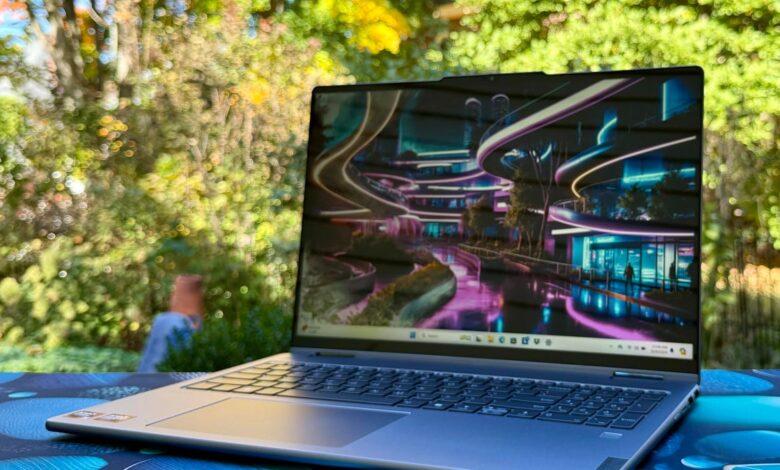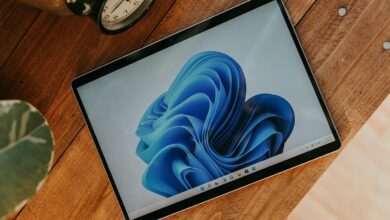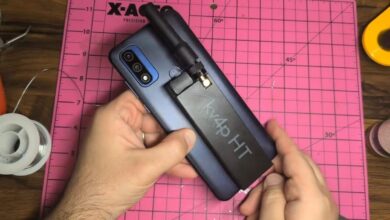Lenovo Yoga 7 16 Gen 9 Review: Big Screen 2-in-1 Laptop With a Small Price

Pros
- Rigid, all-aluminum enclosure
- Competitive performance for the price
- Lengthy battery life
Cons
- Fuzzy text on 16-inch, 2K display
- Weak audio output
- Somewhat unwieldy in tablet mode
The Lenovo Yoga 7 16 Gen 9 continues a trend of midpriced, AMD-powered two-in-one laptops we’ve seen this year. I just reviewed the smaller Yoga 7 14 Gen 9 and, before that, the Dell Inspiron 14 2-in-1 7445 and the HP Envy x360 16. The least expensive of this group, the Lenovo Yoga 7 16 Gen 9, features a Ryzen 5 8640HS processor to the others’ higher-end Ryzen 7 8840HS CPU and half the RAM at only 8GB. However, between this Ryzen 5/8GB config and its Ryzen 7/16GB competitors, the difference in performance isn’t as great as you might think.
Plus, if you want to outfit the Yoga 7 16 Gen 9 with a Ryzen 7 8840HS and 16GB of RAM, you can for $100 more. What you can’t upgrade, unfortunately, is the system’s 1,920×1,200-pixel IPS display. The resolution is fine for general home use of browsing the web, playing casual tablet games and watching YouTube and Netflix, but text looks fuzzy, and images appear a bit pixelated when you are seated close.
A 16-inch two-in-one laptop needs a higher resolution if it’s your everyday workhorse. With its 2.8K OLED display, the HP Envy x360 16 is a better choice as your primary laptop, but it costs a few hundred more than the Yoga 7 16 Gen 9. At $800 — and I’ve seen it on sale at Best Buy for as low as $550 — the Yoga 7 16 Gen 9 is better suited as an inexpensive secondary system for the home or if you just don’t spend a lot of time in front of a computer and want a big screen when you do.
Lenovo Yoga 7 16 Gen 9
| Price as reviewed | $800 |
|---|---|
| Display size/resolution | 14-inch 1920×1200 touch IPS LCD |
| CPU | AMD Ryzen 5 8640HS |
| Memory | 8GB LPDDR5-6400 (soldered) |
| Graphics | AMD Radeon 760M |
| Storage | 512GB SSD |
| Ports | 2 x USB-C 3.2 Gen 2, 2 x USB-A 3.2 Gen 1, HDMI 2.1, combo audio |
| Networking | Wi-Fi 6E and Bluetooth 5.3 |
| Operating system | Windows 11 Home 23H2 |
| Weight | 4.36 lbs (1.98 kg) |
Our Yoga 7 16 Gen 9 test system is a fixed configuration (model 83DM0004US) that sells for $800 at Best Buy and can drop to $550. It features a 16-inch, 1,920×1,200-pixel IPS display powered by an AMD Ryzen 5 8640HS, 8GB of RAM and an integrated AMD Radeon 760M GPU. For storage, it offers a 512GB SSD. There’s also a version for $900 (model 83DM0003US) at Best Buy with a Ryzen 7 8840HS, 16GB of RAM and a 1TB SSD. The improved processor and double the memory and storage capacity are worth the added $100.
There are also two Intel-based models available at Best Buy: a Core Ultra 5 model for $900 and a Core Ultra 7 unit for $1,050. And each can be found for hundreds less when Best Buy’s revolving discounts land on them.
There is no AMD version of the Yoga 7 16 Gen 9 available in the UK or Australia, but you can find Intel Core Ultra models starting at £1,060 in the UK and AU$2,129 in Australia.

Lenovo Yoga 7 16 Gen 9 performance
The AMD models of the Yoga 7 16 Gen 9 are based on the chipmaker’s Hawk Point Ryzen 8040 series released at the end of last year. So, the Ryzen 5 8640HS in our test system is a fairly recent release, but it’s not a member of AMD’s latest Strix Point Ryzen AI series of mobile CPUs. But just because AMD labels this latest generation as “Ryzen AI” doesn’t mean the previous Ryzen 8040 series chips are devoid of AI processing ability. The TOPS count is greater with Strix Point, but Hawk Point CPUs have NPUs capable of 16 TOPS and a platform total of 39 TOPS. (See our TOPS explainer for more information about this metric for measuring AI performance.)
It falls short of the 45 TOPS minimum to be classified as a Copilot Plus PC, but it does offer some of the same AI features you’ll find on a Copilot Plus PC. With the webcam, for example, you get background effects that blur your background and automatic framing that zooms and pans to keep you centered in the fame. You miss out, however, on the portrait light and creative filter effects that you get with a Copilot Plus PC.
Other AI features included on the Yoga 7 16 Gen 9 include the Image Creator tool in the Paint and Photos apps that let you generate images using text prompts. And there’s a Live Captions feature that provides real-time captions and English translations of audio playing on the laptop.

In terms of application performance, the Yoga 7 16 Gen 9 was able to hang close to pricier two-in-one models based on a Ryzen 7 8840HS and the much more expensive HP Spectre x360 16 that has an Intel Core Ultra chip. It was actually better than the Spectre x360 16 on PCMark 10 and the single-core Geekbench 6 test. It fell back on the multicore Geekbench 6 test because its Ryzen 5 8640HS has fewer physical cores and processing threads than the Spectre’s Ultra Core 7 155H chip and the Ryzen 7 8840HS processor in the other models in the charts below.
The Ryzen 5 8640HS has six cores and 12 threads, and the Ryzen 7 8840HS has eight cores and 16 threads. More cores and threads lead to superior multicore performance.
The same holds true with the Ryzen 5’s integrated GPU compared with that of the Ryzen 7. The Radeon 760M chip integrated into the Ryzen 5 features eight graphics cores to the 12 cores you get with Radeon 780M graphics on a Ryzen 7. There’s also a slight difference in the graphics frequency of the two GPUs, but the difference in cores has a greater effect on performance. Neither is going to turn a laptop into a gaming machine, but you can see that the Yoga 7 16 Gen 9 was a step behind the Ryzen 7-based models with Radeon 780M graphics on our 3DMark Time Spy benchmark, with the Intel-based Spectre x360 16 and its integrated Intel Arc graphics leading the way.
The Yoga 7 16 Gen 9 ran for nearly 11 hours on our online streaming battery drain test, which is a good result for such a large-screen laptop. The display is a fairly low-resolution IPS display, which helps; high-res OLED displays tend to consume greater battery resources.
Big display, small sound
The Yoga 7 16 Gen 9 is simply a larger version of the Yoga 7 14 Gen 9 I just reviewed. Both feature a rather straightforward brushed aluminum look and a rigid, all-metal design. The 16-inch version finds room for a dedicated number pad and puts the speaker grill above the keyboard instead of on either side. Unfortunately, Lenovo didn’t outfit the 16-inch model with quad speakers, which would have helped improve the audio output. Many times, larger laptops feature quad speakers since they have the room to include two extra speakers, but the Yoga 7 16 Gen 9 sadly features a basic pair of two-watt stereo speakers that produce typically tinny laptop sound.

In addition to keeping the speakers the same on the 16-inch model as the 14-inch, Lenovo also keeps the display resolution the same. The 1,920×1,200-pixel resolution is sufficient for a 14-inch display, but it’s not quite enough on a 16-inch panel. If you are considering the Yoga 7 16 Gen 9 as your everyday computer and will spend long stretches reading text on its screen, you’ll want something else: text and the edges of images look slightly fuzzy on it. Things are much crisper on the 2,880×1,800-pixel display of the HP Envy x360 16, for example, which also has the added advantage of being an OLED with superior contrast to that of the Yoga 7 16 Gen 9’s IPS LCD.
Still, it’s not the worst IPS panel. It’s rated for a modest 300 nits, and I measured a peak brightness of 379 nits with a Spyder X Elite colorimeter. It’s definitely bright enough to use in even the brightest indoor environments. However, its color performance was poor. It covered only 64% of sRGB, 49% of AdobeRGB and 50% of P3 color spaces.

The Yoga 7 16 Gen 9 weighs 4.4 pounds, which is average for its size. The Envy x360 16 is lighter at 3.9 pounds, and the Spectre x360 16 weighs roughly the same at 4.3 pounds. Compared with the 4.8-pound Apple MacBook Pro 16, it’s appreciably lighter.
Like any 16-inch two-in-one laptop, the Yoga 7 16 Gen 9 is awkward to operate in tablet mode. The hinge is firm enough to support the large display, but the sheer size of the display itself makes folding it around into tablet mode cumbersome. Using such a large display in tablet mode is not as easy as operating a thinner, smaller, and lighter iPad. That said, using it in tent mode for a presentation or with an external keyboard and mouse or in display mode for binge-watching a show makes the convertible design worthwhile.

Is the Lenovo Yoga 7 16 Gen 9 a good laptop?
Yes, the Yoga 7 16 Gen 9 is a good choice if you are shopping for a two-in-one laptop and don’t want to spend a lot on it. It offers competitive performance and long battery life, but it’s better as a secondary laptop that you’ll use for entertainment — watching shows and movies, browsing the web and playing casual tablet games — than a primary computer because its display resolution is a notch below where it needs to be for a 16-inch screen. In this case, the HP Envy x360 16 is worth the added money for its higher-resolution OLED display.
The review process for laptops, desktops, tablets and other computerlike devices consists of two parts: performance testing under controlled conditions in the CNET Labs and extensive hands-on use by our expert reviewers. This includes evaluating a device’s aesthetics, ergonomics and features. A final review verdict is a combination of both objective and subjective judgments.
The list of benchmarking software we use changes over time as the devices we test evolve. The most important core tests we’re currently running on every compatible computer include Primate Labs Geekbench 6, Cinebench R23, PCMark 10 and 3DMark Fire Strike Ultra.
A more detailed description of each benchmark and how we use it can be found on our How We Test Computers page.
Geekbench 6 (single-core)
Dell Inspiron 14 2-in-1 7445 2534HP Envy x360 16 2510Lenovo Yoga 7 14 Gen 9 2444Lenovo Yoga 7 16 Gen 9 2378HP Spectre x360 16 2205
Geekbench 6 (multi-core)
HP Spectre x360 16 11459Lenovo Yoga 7 14 Gen 9 11212HP Envy x360 16 10941Dell Inspiron 14 2-in-1 7445 10279Lenovo Yoga 7 16 Gen 9 9507
PCMark 10 Pro Edition
Dell Inspiron 14 2-in-1 7445 7074Lenovo Yoga 7 14 Gen 9 6867HP Envy x360 16 6671Lenovo Yoga 7 16 Gen 9 6618HP Spectre x360 16 5789
3DMark Time Spy
HP Spectre x360 16 5518Lenovo Yoga 7 14 Gen 9 3107Dell Inspiron 14 2-in-1 7445 2861HP Envy x360 16 2828Lenovo Yoga 7 16 Gen 9 2573
Online streaming battery drain test
Lenovo Yoga 7 14 Gen 9 739HP Envy x360 16 671Lenovo Yoga 7 16 Gen 9 657HP Spectre x360 16 637Dell Inspiron 14 2-in-1 7445 555
System Configurations
| Lenovo Yoga 7 16 Gen 9 | Microsoft Windows 11 Home; AMD Ryzen 5 8640HS; 8GB DDR5 RAM; AMD Radeon Graphics; 512GB SSD |
|---|---|
| Lenovo Yoga 7 14 Gen 9 | Microsoft Windows 11 Home; AMD Ryzen 7 8840HS; 16GB DDR5 RAM; AMD Radeon Graphics, 1TB SSD |
| Dell Inspiron 14 2-in-1 7445 | Microsoft Windows 11 Home; AMD Ryzen 7 8840HS; 16GB DDR5 RAM; AMD Radeon Graphics, 1TB SSD |
| HP Envy x360 16 | Microsoft Windows 11 Home; AMD Ryzen 7 8840HS; 16GB DDR5 RAM; AMD Radeon Graphics; 512GB SSD |
| HP Spectre x360 16 | Microsoft Windows 11 Pro; Intel Core Ultra 7 155H; 16GB DDR5 RAM; Nvidia GeForce RTX 4050 graphics; 1TB SSD |






